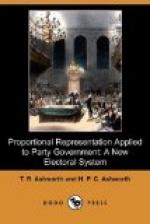+Rules for the Reform.+—We are now in a position to draw up a list of rules for the proposed reform, applicable to all legislatures in which party government prevails:—
1. Electorates to be grouped so as to contain at least three seats, and preferably not less than five seats nor more than twenty seats.
2. Candidates to declare when nominating, or a few days before the election, whether they are in favour of or opposed to the party in power, and to be classified accordingly as Ministerialists or Oppositionists.
3. Ballot papers to contain the names of all candidates nominated, arranged in two parallel columns, one headed Ministerialists, and the other Oppositionists. The list of candidates under each heading to be arranged in alphabetical order.
4. Each elector to have as many votes as there are seats, and to be allowed to give either one or two votes to any candidate. The votes to be distributed as he pleases among all the candidates of both lists.
5. The total number of valid votes cast at the election to be divided by the number of seats; the quotient to be known as the “unit of representation.”
6. Each party to be allowed one seat for every whole unit of representation contained in the aggregate votes polled by all its candidates, and the last seat to go to the party which has the larger remainder.
7. The candidates of each party having the highest number of votes to be declared elected to the number of seats to which each party is entitled in accordance with the preceding rule.
8. In case of a tie between candidates or parties the lot decides.
The alternative plan for rule 4, which is somewhat simpler, would read as follows:—
4. Each elector to vote for half the number of candidates that there are seats, i.e., three votes in a five or six-seat electorate, four votes in a seven or eight-seat electorate, &c. The votes to be distributed as he pleases among all the candidates of both lists.
It is unnecessary to dwell on the absolute simplicity of these rules. They involve no radical departure from existing methods of voting or of counting votes. Once the totals are added up, the calculations necessary to decide the successful candidates are within the reach of a school child.




